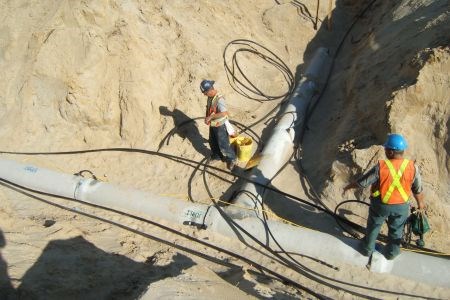With expectations that global energy costs will climb ever higher in the coming years, Renewable Resource Recovery Corp. (R3C) is banking on the reliability of the world’s greatest energy source: the sun.
As a manufacturer of a specialty concrete sewer pipe for geothermal heating and cooling, the Sudbury company continues to expand the scope of its line of green energy products, following growing international interest.
“People are very concerned we’ve hit ‘peak oil,’ where costs go up, availability goes down, and energy costs start to get extremely high,” says John Hood, director of R3C, and co-inventor of the product.
“The nice thing about this system is there will never be peak anything. The power comes from the sun, and it will always be there, so that means it’s a consistent energy system, and the costs can remain fairly consistent.”
The company’s signature product remains its @Source-Energy Pipe. It is manufactured in Sudbury by Rainbow Concrete, whose president, Boris Naneff, serves in the same role at R3C.
At Naneff Gardens, his 18-lot subdivision in nearby Garson, the geothermal sewer pipe has been installed throughout each lot, and several homes have been purchased and built as a result. These efforts were rewarded by the Northern Ontario Heritage Fund Corporation, which provided the company with $100,000 in mid-October.
To further validate the efficiency of the system, the company ran tests this summer on pipes installed at the subdivision. Real-world data was gathered on the system’s ability to conduct heat, in collaboration with a professor from the University of Oklahoma, who interpreted the results.
These showed that the installed system was capable of producing roughly 30,000 British thermal units (BTU) per hour, or enough for a 1,200-square-foot home.
This places the system just one notch below the best-performing type of geothermal system, which is a vertical pipe driven through solid rock.
It also means that instead of having to supplement the system with standard geothermal wells to heat particularly large homes, the company can instead simply use additional lengths of its specialty pipe.
This was reinforced through the use of the pipe at a stand-alone home in nearby Chelmsford, which was successfully kept heated at a steady 25 C throughout the winter.
What’s more, for a 1,500-square-foot home, the system’s reduction in carbon emissions is the equivalent of taking three cars off the road. This provides the team with ammunition as they enter talks with a variety of parties who have come knocking after word of their invention has emerged.
Discussions are currently underway with representatives of the City of Spokane, Wash. who are looking to replace sewer pipes along some of its major roadways. Similar preliminary conversations are being held with officials in the Chinese city of Tianjin, who are “very, very interested” in the @Source-Energy Pipe.
Closer to home, the City of Greater Sudbury has been involved with the Naneff Gardens pilot projects, examining the results as some local condo developers are considering making use of the product.
The product hasn’t gone unnoticed by industry, having won a “specialty concrete products” award at the 2009 Ontario Concrete Awards, held in Toronto last December.
Successes have been such that the company is already moving forward with another new product idea, a lightweight, aluminum-framed roof panel. Early tests have shown it to generate 10 per cent more electricity than a standard photovoltaic panel, while the additional heat produced by such units can then be pumped into the home to contribute to heating, or back into the company’s sewer pipe.
“If you just want to heat your hot water, it can do that too,” says Les Lisk, also a director and inventor with R3C.
So positive are the results that Lisk expects that a small five-person manufacturing plant could be opened in the city as early as next summer. Financing for the project is being sought from provincial and federal sources.
Testing is also underway on its @Source Energy Wall, a precast concrete wall that uses photovoltaics and heat absorption to generate both electricity and warmth for the home. One of the Naneff Garden homes under construction is set to make use of this technology.
The early positive response to its offerings has been a vindication for the four inventors and company founders, which include Hood, Lisk, Naneff, and Toronto-based energy consultant Robert Mancini.
Having first met at various green energy conferences, the four devised a specialty pipe, a system where high-density tubing is wrapped around the wire mesh that forms the core of the pipe, which is then encased in concrete. A mixture of water and ethanol in the tubing absorbs the heat from the surrounding earth, as well as the effluent in the concrete pipe itself.
The system is connected to a geothermal heat pump in the building, which replaces a standard furnace. This extracts the heat from the liquid — which sits between 40 and 50 degrees Fahrenheit — and expands it to standard room temperatures.
Because of the small 20-degree temperature difference between the two, very little energy is required to heat a home with this system, creating efficiencies of up to 500 per cent.
Hood estimates that homeowners will save a minimum of $500 to $1,000 a year on their annual heating bill. The product is designed so it is also capable of drawing heat out of a home and pushing it back into the system during warmer weather, thereby cooling the building as well.
Given the logistics and the sheer weight of concrete, the company will license out both the manufacturing and the energy system management to interested parties in other cities.
Currently, R3C’s products are being produced by Rainbow Concrete.
www.r3c.info




